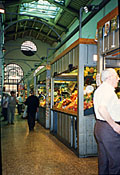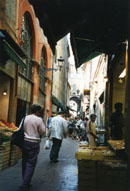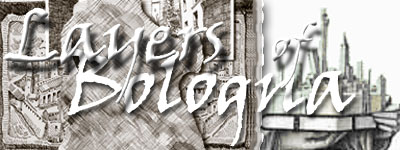I continue on Via Clavature as it goes toward
Via Castiglione, from Nicolò dell'Arca and the Renaissance,
through the Roman criss-cross of streets in the neighborhood of the
Quadrilatero, the oldest part of the city. Meanwhile, I bump into a
delicious mix of ancient Rome, the Middle Ages and modern Bologna.

The narrow, regular checkerboard streets reflect their origin
as a Roman market. Even as layers of Bologna's history emerge, I
nevertheless find myself ogling the merchandise in the windows of
the elegant shops that line Via Clavature: fashionable clothing,
trendy or functional housewares, excellent bread and tempting,
characteristic cookies. They and the Mercato Coperto are closed until
later so I can only window-shop, which is just as well. In the
tranquillity of the early afternoon, I soak in the shades of Bologna's
ocher -- from mustard and gold to rust and rosy red. The inevitable
shadows cross my path and the sunlight plays off the houses rising up,
one then another, leaning, leaning, it seems, one against the other.
Their green-shuttered windows open onto the street like eyes that have
watched the centuries walk by below. What secrets do they hold? Are
they too tired to watch as I pass today?
The names of the tiny streets that cross Via Clavature derive
from the Middle Ages and designate the artisans and merchants who once
inhabited them. For instance, Via Clavature itself was the street of
the locksmiths. Other metalworkers would have populated Via Orefici
(goldsmiths) and Via Spadari (sword-makers). Merchants of foodstuffs
would have been found on Via Pescherie Vecchie (fish) and Via Caprarie
(meat), while Via Drapperie (textiles) and Via Calzolerie (shoes) would
have been the home of those trades. Then too, surprises hide in
unexpected corners in the nooks and crannies of the immediate
neighborhood. Just turn left or right from Via Clavature onto one of
the little cross-streets and look for hidden osterie, tiny shops or
quiet bars.

On the left, just after Via Drapperie (n. 16-18) a group of
houses that overhang the street show the evolution of Bologna's
porticoes. The small bulge, then a bigger one and finally, the
full-fledged, though narrow, portico allowed the proprietor to
expand the living space in his house to accommodate university
students and earn money ("Com' è Bella: Life
Under Bologna's Porticoes").
While I meander, I contemplate the Renaissance and the
Bentivoglio family, especially Giovanni II, whose term of power
(1463-1506) represented a relatively calm period in the normally
tempestuous history of the city. Because of his wealth and prestige,
important artists like Francesco Francia, Lorenzo Costa, Jacobo della
Quercia, Nicolò dell'Arca and even a young Michelangelo
received commissions and worked in Bologna. (See the painting
Madonna in trono col Bambino e i ritratti di Giovanni II Bentivoglio
e della famiglia (1488) by Lorenzo Costa in the church of
San Giacomo Maggiore, Piazza G. Rossini.) His reign ended violently
though when the papacy again gained control of the city and Giovanni
had to flee into exile. The angry masses proceeded to level his famous
palazzo, with its nearly 300 rooms. (Palazzo Bentivoglio's tower is
visible in Francesco Francia's Madonna del terremoto (1505),
a fresco in the Sala d'Ercole of the Palazzo Comunale in Piazza Maggiore
.

